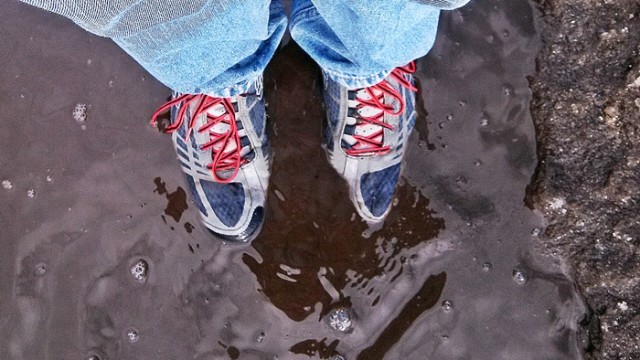Back in 2010, we tested Wenger’s Canyoneer boot, and loved them for a variety of reasons. One of the top reasons was their then-unusual OutDry waterproofing system, which worked flawlessly and allowed a lighter, cooler boot than any of the bootie-style waterproof breathable membranes (i.e., Gore-Tex, etc.). We were so impressed with the boot in general that two testers bought them for themselves; nearly 5 years later, both pairs are still in use, and both are still fully waterproof.
But, times change, and in this particular case OutDry had a major change; Columbia Sportswear bought the technology. That’s a BIG deal; Columbia is the 500 pound gorilla of the sportswear business, with over $2 BILLION in sales in 2014. That ain’t chump change (in fact, we probably could retire on the funds in their petty cash box), and it gives them the ability to invent new technologies and market them without worrying about going under because of it. The fact that they chose to buy OutDry speaks volumes; most of their innovations (Omni-Heat, Omni-Tech, and more) are developed in house, so they clearly saw the same potential that we did.
The question is…now that OutDry is being used in more ways, is it really a better mousetrap? Or, was it just a fluke that it worked so well in the Wenger boots? We decided to assemble a variety of products and run them through the wringer (and mud puddles, rainstorms, backcountry ski trips, anything wet that we could find). And, cutting to the chase, we found that yes, OutDry really is better…and no, it really isn’t.
The Minimalist Membrane
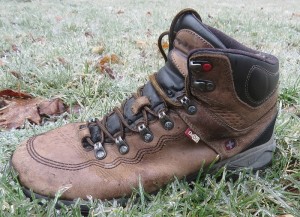
For starters, what exactly IS OutDry, and why is it different from all other waterproof/breathable membrane systems? Notice that we used the word “systems,” because that’s what we’re dealing with. Waterproof/breathable membranes are a dime a dozen, and they all work to some extent, and all BUT OutDry basically work the same way. The membrane is sewn into the liner of a product, effectively creating a bag that allows perspiration to pass through to the outer layer, but keeps water out. It adds multiple layers to the garments, and creates space for water to collect between the outer shell and the actual membrane. In field use, that can mean a significant increase in weight, even when it’s working; anyone who has had a waterproof pair of leather hiking boots get saturated knows that they can gain a LOT of weight. There’s also a significantly greater chance for the waterproofing to fail (at least, in theory); with taped seams and a lot of flexing, it’s easy to see how problems could occur over time. OutDry, on the other hand, uses a membrane kit that is cut to fit exactly in the shoe or glove it’s made for, and then is bonded directly to the inside of the outer shell. The shell itself acts as a matrix to protect the membrane, limiting the flexing and pulling that can come with standard techniques, and there’s no room for water to pool between the shell and the membrane. Added weight is decreased, drying time of the boot or glove is decreased, and warmth is increased, as there is less water to suck your body heat away. In the case of gloves, there’s another advantage; by reducing the thickness of the waterproofing, there can be increased dexterity (depending, of course, on the amount of insulation in the particular glove).
All in all, it’s a pretty impressive set of benefits, IF it works. We knew already that it worked to some extent from our earlier testing, but that’s one product. After playing with two more pairs of shoes and five pairs of gloves, though, we’ve learned a lot, and have a better handle on the possibilities, and limitations, of the technology. Here, product by product, are the ones we tested, and our comments about each. Several were from Columbia, but we also got some gloves from Ergodyne, who has licensed the technology. Interestingly, they actually use OutDry in their PROFLEX® 730OD gloves as a contamination barrier for bloodborne pathogens; we had ZERO interest in testing those! But, it’s quite a statement of how confident they are about OutDry not letting anything IN…great, but we also wanted to know if they let moisture OUT. Read on…
OutDry Footwear
First, the footwear. Since our initial exposure to OutDry came from hiking boots, we wanted to expand on that first. We tried two Columbia models, with outstanding results in different uses; here you go:
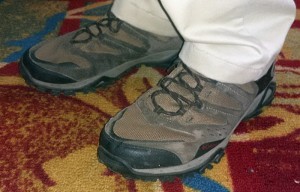
Columbia PeakFreak
Since the Wenger was a serious hiking boot, we wanted to see what more of a crossover product would be like, and the PeakFreak was perfect for that. Ostensibly designed for trail hiking, it has a look that is perfect for daily use in everything but “serious” business situations (sorry, we couldn’t find any OutDry wing tips, although that’s NOT a bad idea!). The sort of chunky look was fine for urban chic; okay, you wouldn’t pair them with skinny jeans, but we can’t fit into those anyway. Jeans, khakis, chinos, Dickies, Carhartt, all looked natural with the shoes. And, what we found was entirely positive. The shoes were absolutely, utterly waterproof in every situation we tried them, from wet grass morning strolls to sudden summer thundershowers. Perhaps better still, breathability was outstanding; long days at conventions didn’t leave us with white, wrinkled feet. We found the name to be a bit optimistic, though; the shoes themselves aren’t hyperlite, and wouldn’t be our choice for peakbagging. Overall, the shoes got high marks on their own merits, but OutDry worked flawlessly in them.
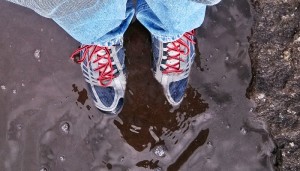
Columbia Conspiracy II
With boots and crossovers covered…what about trail runners? That’s an activity that can start out dry and get wet VERY quickly, and heavy, soaking wet shoes not only slow you down but definitely can reduce the enjoyment factor. Out of the box, our runners loved the Conspiracy IIs. Fit was good, the heel pocket was tight enough to keep the shoes on when we hit sucking mud, traction in a range of conditions was excellent. Considered on their own merits as shoes, we had no issues with them, but the OutDry was the icing on the cake; really, really good icing. As in the other two shoes we’d tried, it was simply flawless at keeping water out, and nobody could even tell that it was THERE; it just seemed like a regular trail runner. When we DID get wet by going in over the top of the shoes, they dried quickly, since there wasn’t any multi-layer bootie to hold it in. The temperature range was outstanding, as well; since the waterproofing is right inside the outer surface, they didn’t soak up cold water in winter/spring runs and chill our feet, but the lack of insulating layers and great breathability kept them comfortable in the heat of summer.
The Takeaway
So, for uninsulated footwear, OutDry came out with absolute gold star ratings; we simply couldn’t find a flaw. Actually, there’s ONE flaw; the range of footwear using it is…well, a limited number of items made by Columbia. That leaves the buyer stuck with hoping that Columbia’s lasts fit their feet, and that they make a model that fits their needs. At latest count on their site, that means 2 men’s models, 1 for women. That’s at best a C- rating in our book; we’d like to see Columbia license out the technology to other footwear manufacturers.
OutDry Gloves
Luckily, when it comes to gloves, they HAVE licensed Ergodyne, which dramatically increases the range of products available, both in quantity and in characteristics. Columbia has chosen to use the technology, at this point, only in cold weather gauntlet style gloves. Nothing wrong with those, but they aren’t what everyone is looking for by a long shot. And, again, the selection is very limited; 2 for men, 2 for women. Bah, humbug. By comparison, Ergodyne, a much smaller company that’s geared toward the industrial market, has 4 unisex models that use the technology. Do those numbers seem backward to you? Yeah, they do to us, too.
Where in footwear we found OutDry to be flawless, in gloves…well, the results were a bit mixed. Read on for the specifics!
Ergodyne ProFlex 818OD/819OD Gloves
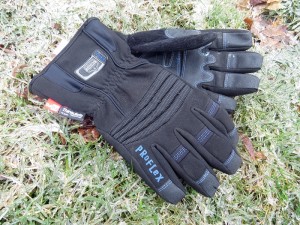
While the 818OD and 819OD
vary in important details (the finger protection is different, the 819OD is gauntlet style and is more flexible, etc.), for the purposes of reviewing how the OutDry is working they’re functionally the same. And, that’s a GOOD same, in all ways. The gloves themselves are a little stiffer than we’re used to for, say, backcountry skiing; the materials were chosen for durability in work situations, not for long days wrapped around a ski pole handle. And, for work they got an absolute A+ rating from a contractor we know; we handed them over, he laughed at them for being way too thin and not having enough insulation for outdoor winter work; weeks later, he came back with his tail between his legs and glowing comments. And, not shockingly, his comments centered around dry hands; wet snow didn’t soak through, and they didn’t get all sweaty inside (he also commented on them lasting a lot longer than he expected; kudos to Ergodyne for making rugged gear!). We can echo those comments; the Ergodyne pair were a huge help in setting up winter campsites. You’re constantly digging through snow to set pegs, make room for woodstoves, you name it; even though the gloves were stiffer than we’re used to, the thinner material more than made up for it. In a heated tipi, the snow gets REALLY wet, but the 818OD/819OD pair never wet through. The 40g Thinsulate insulation acted warmer than we would have expected; our belief is that the superior moisture transport kept the efficiency of the insulation higher than in typical situations.
And, when used in aerobic activities, they still performed. Breathability was nearly on a par with such favorites as the Outdoor Research Stormtracker; the fit and feel weren’t anywhere near as nice, but the tradeoff of having them be waterproof (the Stormtrackers are a Gore Windstopper glove, so only somewhat water resistant) made them winners in nasty conditions. During high aerobic activity, they would get damp inside, but only to a certain point; it seemed to us that it was less a matter of not passing the moisture through, and more a time lag before it could all get through the lining. Ultimately, for a glove that wasn’t designed for what we do, we were exceptionally pleased at how often we reached for them over some better known brands.
Ergodyne ProFlex 925F(X)OD Gloves
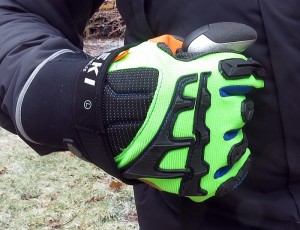
No, we didn’t make that name up…it really has all of those letters and numbers. And, the 925F(X)ODs have a look that matches up; totally over the top. The two major comments were “Those are the ugliest things I’ve ever seen,” and “Those are SO cool!” Nothing like a little polarization; if you’re into Bach, they’re probably not your style, but if your favorite artist has ever used the word “bling,” you’re in. But, either way, the sidecountry/backcountry skiers loved them for their knuckle and back of hand protection. When we told them that they retail for $70/pair, they were astounded; typical prices for downhill gloves with protection are a LOT higher. The neoprene cuff pulled on well, and tucked easily into most jackets, keeping snow from getting inside.
But, as always, the concern is more getting water OUT than keeping it in. Backcountry skiing is pretty high aerobic activity; just listen to anyone who has been working through trees wheezing like a steam engine, and it’ll be obvious. And, the limitations of OutDry started to show up here. On downhill legs, the ProFlex 925F(X)ODs performed very well, keeping us warm enough until the thermometer really plummeted; but, climbing back up, they’d start to get clammy. That’s not a huge surprise, and they didn’t perform worse than many of our regular choices; we just, being natural gluttons, wanted to have it all. And we can’t. But, what we CAN say is that now that we’re technically out of testing, the ProFlex 925F(X)ODs are still being used, happily, by our more radical backcountry enthusiasts. Like all of the other OutDry products we tested, we simply don’t have to worry in the slightest about water getting in from the environment, and that peace of mind goes a long way!
Columbia Inferno Range Gloves
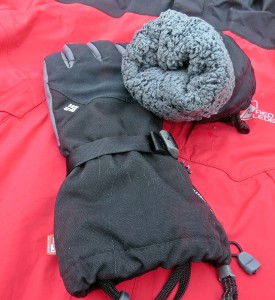
Being catty, we’ll say that we can’t understand the name on these; “Inferno” is far from the truth, and “Range” is exactly where we didn’t want to be with them. In fact, one tester summed it up: “Best warm weather snowblowing gloves I’ve ever used.” Wait a minute…these are big gauntlet style gloves, with a lot of nice, warm pile insulation, and they’re waterproof…what’s wrong here?
Simply put, we’ve never tested a glove where we ended up so wet (from inside) so fast. Breathability was absolutely non-existent in temperatures that were significantly below freezing. Even in basic alpine skiing, testers were complaining that their hands were damp after a single run. When they first put them on, they thought they’d be warm, but that obviously didn’t last long. What they were best at was, as our friend said, warm weather snowblowing; in other words, totally non-aerobic activity where the need for moisture transport was limited. And, the outdoor temperature was key, too; get down around 25 or below, and we’d start to feel them getting cold, fast. Clearly, the colder it got, the less they were able to breathe, and holding that moisture in made them suck the warmth right out of our hands.
Just to make sure that the problem was us (as in, OUR sweaty hands), we did a version of our shoe torture test; stuck our hands in 8 inches of water and held them there for 10 minutes. And, no water came in, so the OutDry was working perfectly in that way. Hmmm…one more data point to add to the test, with one pair of gloves to go!
Columbia Titanium Winter Catalyst Glove
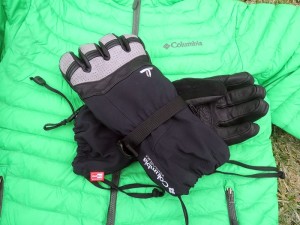
Columbia’s “Titanium” label, which used to be on the best of their gear, is coming back, and these are a worthy re-entry point. A gorgeous design, with precurved body & fingers and beautiful leather work on the palm and back of the hand, they’re built for serious abuse but have looks that aren’t out of place when you’re hanging with your rich friends. And, here’s the kicker…they work. They’re basically as good at managing moisture as the Inferno Range aren’t. These are moderate temperature gloves; we found that with a light liner glove, they were good down to the low 20s, but they definitely aren’t designed for manipulating carabiners on Everest. In those conditions, multiple downhill runs left us with no clamminess problem, a huge improvement over the Inferno Ranges. In backcountry uphills, we had similar issues to those with the Ergodyne ProFlex 925F(X)ODs; we could sweat enough to overcome the ability of the glove to move the moisture out. But, we didn’t feel it was excessive, and in those conditions we’d typically take the heavier gloves off anyway…it’s really a stacked deck to expect any well insulated glove to work well when we’re doing high aerobic activity. Overall, we were very happy with both the waterproof and breathable portions of their performance; they did the job they were designed for, and did it well.
Factoring The OutDry Equation
So, what to conclude from all of this testing? First, that we’re comfortable recommending OutDry waterproofing, period. We had zero failures throughout the testing; that’s almost unheard of. We can’t count the number of failures we’ve had in testing products using more traditional waterproof/breathable methods, including with expensive products from highly regarded high-end manufacturers. OutDry was simply outstanding in this regard.
Beyond that, the advantage of having the membrane bonded directly to the outer layer showed other benefits. Since water is blocked at the surface, rather than a couple of layers in, products gain less water weight in wet conditions. That means those days of slogging along in wet, heavy boots can be gone; the day may be wet, but the boots won’t be. Assuming, of course, that you can actually BUY some boots that use OutDry; until Columbia dramatically increases their product offerings or licenses the technology to other manufacturers, we’re all sort of stuck.
In addition, we generally found products to provide more warmth in really soggy conditions than we’d have expected. Our theory here is that, since heat moves from our body faster in wet conditions than in dry, having less water actually IN the gear means that we aren’t constantly trying to warm that water and having that heat released to the great outdoors. The effect was particularly noticeable with the Conspiracy II runners; since they have absolutely no insulation, and we used them in ridiculously cold/wet conditions where we’d normally expect to come back in with numb, white feet, there was no question that they were offering us more warmth, or more accurately allowing us to retain more of our warmth, than any other lightweight trail runner we’ve ever used.
At the same time, the Conspiracys helped make the limitations of OutDry more clear to us. With virtually nothing between our sweaty feet and the membrane but our socks, we simply weren’t able to create a situation where we overcame the membrane’s ability to transport the moisture out of the shoe. At the opposite end of the spectrum, we could overcome the Inferno Range gloves in no time flat; it seemed like NO moisture was passing through the membrane.


